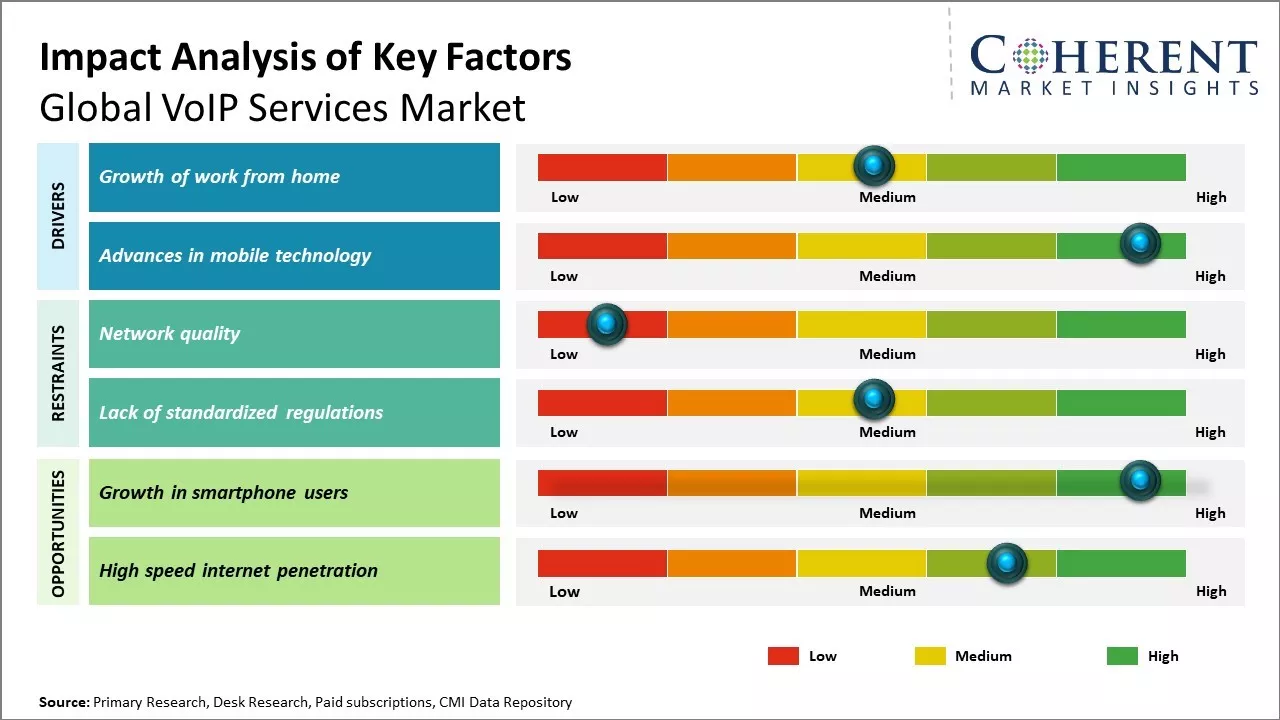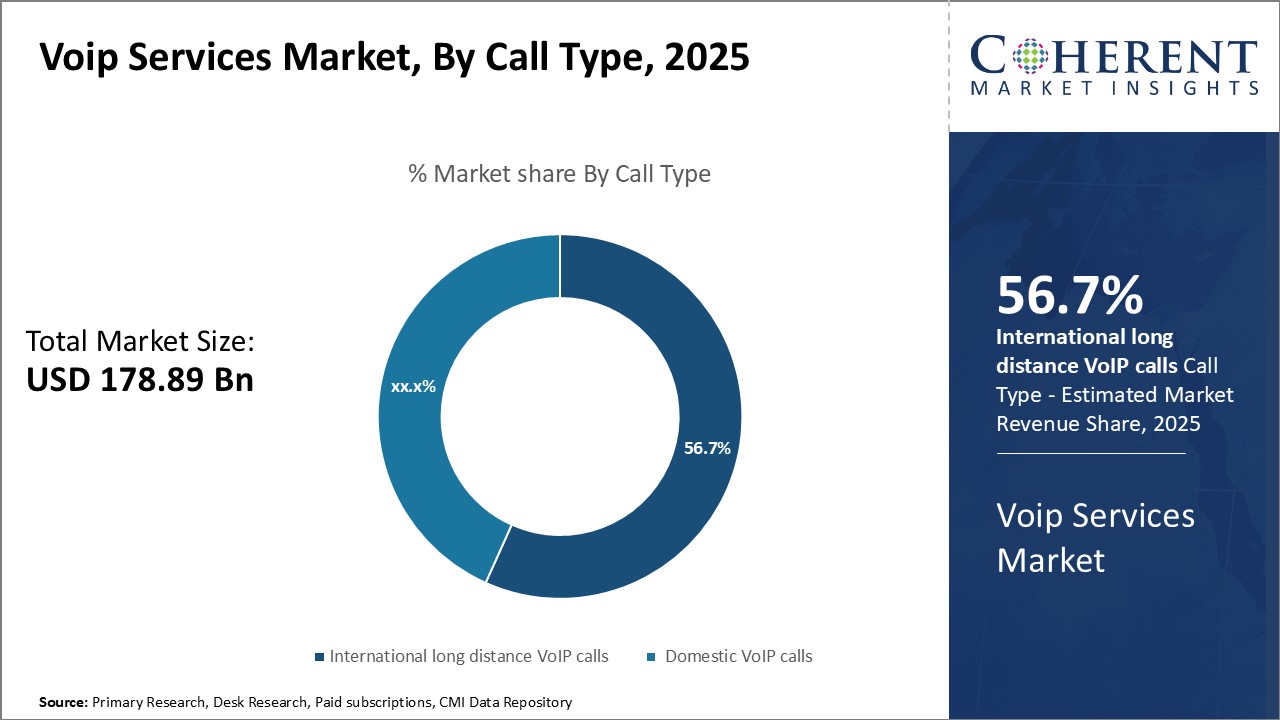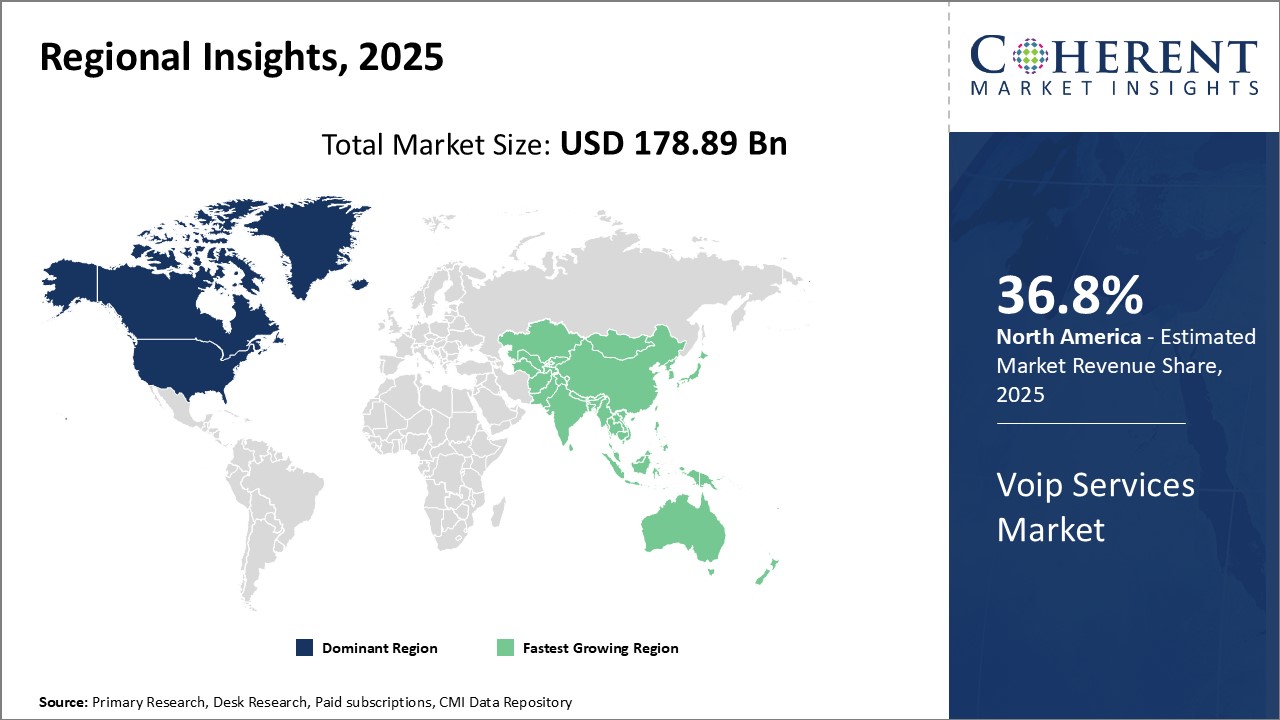Global VoIP services market is estimated to be valued at US$ 178.89 Bn in 2025 and is expected to reach US$ 413.36 Bn by 2032, exhibiting a compound annual growth rate (CAGR) of 12.7% from 2025 to 2032.

Discover market dynamics shaping the industry: Download Free Sample
The widespread adoption of cloud-based technologies and mobile VoIP applications can boost demand for VoIP services across industry verticals such as BFSI, IT & Telecom, Healthcare, Media & Entertainment, Retail & e-Commerce, etc. The market is witnessing significant growth due to increasing internet penetration and decreasing costs of broadband that has made VoIP services affordable for consumers and enterprises. Furthermore, growing remote working trend accelerated by the pandemic can boost demand for VoIP solutions that allow seamless communication. Key players are focusing on incorporating new technologies like AI and blockchain to enhance VoIP service offerings.
Growing work from home
The COVID-19 pandemic compelled governments to implement stringent lockdowns, mandating employees to work remotely to ensure business continuity and curb the virus's spread. While some organizations were better equipped to enable remote work, the pandemic hastened the widespread adoption of work-from-home policies almost instantaneously.
This rapid transition brought advantages as well as challenges for companies and employees. It also highlighted how technologies such as voice over IP can maintain connectivity and collaboration even when teams are separated geographically. With workers becoming accustomed to the flexibility and other benefits of working remotely, many businesses now plan to continue supporting virtual and hybrid work setups even after the pandemic subsides.
As work from home becomes more mainstream, there will be a greater reliance on cloud-based communication tools and services that does not require people to be co-located. Virtual private networks and VoIP solutions play a vital role in keeping remote employees engaged with colleagues and clients as if these people were in the same office. These enable seamless phone calls, video conferences and messaging across various devices regardless of physical location. This rise of hybrid work models can drive the global VoIP services market as enterprises invest in supporting a more distributed workforce through digital transformation of their communication infrastructure.
For instance, in May 2020, VoIPStudio, a leading provider of cloud-based business communication solutions, announced the expansion of its service offerings to include an emergency calling feature. This new capability enables VoIPStudio customers to connect directly with public safety organizations, enhancing the platform's regulatory compliance and providing businesses with a comprehensive, enterprise-grade communication solution.

Get actionable strategies to beat competition: Download Free Sample
Advances in mobile technology
The proliferation of mobile devices and applications is a key driver of market growth. Smartphones have become ubiquitous, with mobile internet and app usage experiencing a massive spike globally. Forward-thinking businesses are leveraging this shift to develop innovative communication services that can be accessed on-the-go from any device or network.
As underlying technologies evolve, VoIP solutions are gaining new capabilities such as high-definition voice calls, video chat features, advanced conferencing options, swift messaging functions, and integration with other productivity tools, CRM systems, and collaboration platforms. Combined with the ever-improving processing power, battery life, and internet speeds of mobile devices, these solutions deliver a seamless experience that enhances productivity and collaboration for businesses.
The convergence of mobile technology advancements and the growing demand for flexible, on-the-go communication tools presents a significant opportunity for providers of VoIP and unified communication services. Businesses can leverage these solutions to improve employee connectivity, streamline workflows, and drive operational efficiency, ultimately enhancing their competitiveness in the market.
Key Takeaways from Analyst:
Global VoIP services market can witness growth due to cost-savings and flexibility offered by VoIP technologies. There has been rising demand for VoIP from small and medium businesses as it removes infrastructure needs and allow business communication from anywhere. North America currently dominates the market due to early technology adoption and presence of global VoIP players. However, Asia Pacific is expected to emerge as the fastest growing region due to increasing internet penetration and growing mobility.
Lack of standardized regulations and concerns around security of VoIP can hamper the market growth across regions. VoIP providers will need to address interoperability and roaming issues to gain traction in business segments. Vendors should focus on convergence of VoIP with mobility and collaboration tools and offer innovative pricing models. Favorable regulations supporting VoIP adoption can strengthen growth in underpenetrated markets.
Market Challenges: Network quality
The quality of network infrastructure poses a significant challenge for the growth of the global VoIP services market. While VoIP technology provides cost-effective and feature-rich calling solutions, the user experience largely depends on the reliability of the underlying network. Many regions around the world still grapple with inconsistent network connectivity issues due to factors such as limited broadband penetration, fiber connectivity, and bandwidth constraints.
This lack of robust network infrastructure presents a critical barrier to the widespread adoption and seamless performance of VoIP services. Businesses and consumers in these regions may experience poor call quality, dropped connections, and other network-related issues, which can undermine the value proposition of VoIP solutions and hinder their overall market penetration.
To address this challenge, VoIP service providers must work closely with network infrastructure providers and local authorities to invest in upgrading and expanding the network capabilities in underserved areas. This may involve initiatives to improve broadband access, increase fiber optic coverage, and enhance overall network reliability and bandwidth. By addressing the fundamental infrastructure limitations, VoIP providers can unlock the full potential of their solutions and deliver a consistently high-quality experience to their customers.
Market Opportunities: Growth in smartphone users
The proliferation of smartphones presents a massive opportunity for the global VoIP services market to expand rapidly in the coming years. As smartphones have become ubiquitous worldwide, more people are now connected to the internet at all times through their mobile devices. According to data from the ITU, over 95% of the world's population now lives in an area with mobile broadband coverage. As internet access becomes more affordable and accessible through smartphones, consumers are increasingly preferring to use Over-The-Top communication apps rather than traditional phone plans.
This shift in consumer behavior is a significant driver for the growth of the VoIP services market. Businesses can leverage the widespread adoption of smartphones and mobile internet to develop innovative communication solutions that can be accessed on-the-go. By offering VoIP services optimized for mobile platforms, providers can cater to the growing demand for flexible, cost-effective, and feature-rich communication tools among both individual and enterprise customers.
The convergence of mobile technology advancements and the rising preference for internet-based communication presents a lucrative opportunity for VoIP service providers to expand their market share and capture new revenue streams. As businesses and consumers increasingly rely on seamless, ubiquitous communication, the availability of high-quality, mobile-friendly VoIP solutions will be a key differentiator in the competitive landscape.

Discover high revenue pocket segments and roadmap to it: Download Free Sample
Insights, By Call Type- Lower costs can drive the international VoIP calls segment
In terms of call type, international long distance VoIP calls segment is estimated to contribute the highest market share of 56.7% in 2025, owing to significant cost savings over traditional phone lines. Making international phone calls using traditional telephone networks can be extremely expensive due to long distance fees and additional international calling charges added by telecom providers. VoIP technology leverages the internet to route phone calls, eliminating costly per minute rates and reducing the overall cost of an international call to just a few cents on average.
This large difference in calling costs boosts popularity of international VoIP services. Individual consumers and businesses both seek to reduce communication expenses and improve their budgets. Migrant groups and expat communities also heavily rely on VoIP apps like Skype, WhatsApp, and Facebook Messenger to frequently contact friends and family abroad. The ability to make high quality voice and video calls internationally for free or at nominal fees has revolutionized long distance communication globally.
Technological advancements have improved the quality and reliability of international VoIP connections. Issues like latency that previously plagued overseas calls have been significantly reduced through innovations in internet infrastructure and VoIP software. Consumers now experience clear, high definition calls that feel nearly instantaneous when connecting with someone on the other side of the world. This has removed a major barrier and boosted confidence in using internet-based telephony for important discussions instead of traditional phone lines.
The cost savings and improved calling experience has shifted consumer behavior significantly. Many people now use international VoIP as their primary method of long distance communication rather than landlines or mobile networks.
Insights, By Configuration- Computer-to-Computer segment dominates due to ubiquitous internet access
In terms of configuration, computer to computer segment is estimated to contribute the highest market share of 44% in 2025, owing to universal internet connectivity through laptops and desktop PCs.
Computers have firmly established themselves as essential tools in both personal and professional life. Billions of people worldwide use laptops, desktops, or 2-in-1 devices on a daily basis for activities ranging from work and education to entertainment and socialization. With internet infrastructure spreading globally, computer ownership is often people's first point of access to the web through both mobile data networks and fixed broadband connections.
As computers are usually always online, these provide a convenient medium for making impromptu VoIP calls. Users can communicate through applications like Skype, WebEx, or Zoom directly from their existing workstation without any additional equipment or setup.
Businesses especially rely heavily on computer-based collaboration solutions to boost productivity through virtual meetings and remote operations. The option to quickly start video conferences or screen shares from one's desktop simplifies coordinating projects between international offices and remote workforces. Consumers also value being able to connect visually with friends and family face-to-face while using computers for other online activities.
Widespread internet access through PCs drives the computer-to-computer segment growth.
Insights, By Vertical- Enabling better customer engagement boosts adoption of VoIP in IT/Telecom
In terms of vertical, IT & Telecom segment is estimated to contribute the highest market share of 38.3% in 2025, owing to VoIP's capabilities for enhancing customer service. Contemporary consumers exhibit elevated expectations regarding their interactions with companies, anticipating timely responses through their preferred communication channels. Relying solely on traditional phone support is no longer adequate as the primary point of contact.
VoIP technology allows telecom and internet service providers to offer multilayered support via different channels like web-based chat, co-browsing, video conferencing, and collaboration tools in addition to traditional phone lines. Customers appreciate having various self-service options available 24/7 as well as live assistance through their preferred medium be it online messaging or a phone call. This omnichannel support powered by VoIP transforms a routine customer service interaction into a personalized experience that drives satisfaction.
VoIP solutions also empower remote sales, customer onboarding, and tech support without physical storefront limitations. Agents can securely access internal systems from any location to efficiently handle consumer queries.
Furthermore, integration of VoIP phone systems with existing business communications and CRM tools provides telecom firms with invaluable consumer insights. Call center analytics help pinpoint issues or trends and optimize the customer journey.
These advantages are critical for highly competitive telecom businesses catering to increasingly digitally-savvy clientele who switch providers over mediocre service.

Need a Different Region or Segment? Download Free Sample
North America dominates the global VoIP services market with an estimated market share of 36.8% in 2025 due to strong technology adoption and high internet penetration in countries like the U.S. and Canada. The region is home to major VoIP service providers and networking equipment manufacturers that have been involved in the development of advanced VoIP technologies and solutions. Trends like work from home and online schooling amid the pandemic have accelerated VoIP usage in the region.
The presence of large enterprises from various industries in North America boosts demand for VoIP phone systems to improve communication and collaboration within distributed workplaces. These companies are focusing on technologies to enhance productivity and optimize costs. Moreover, factors like fast connectivity, equipment availability and technology skills have facilitated swift integration of VoIP communication across departments and branches in the region.
Asia Pacific is expected to witness the fastest growth in the VoIP services market. Penetration of low-cost internet and rising use of smartphones have boosted VoIP adoption, especially among small businesses in nations like India, Indonesia and Vietnam. Countries in South-East Asia, coupled with strong economic development and improving connectivity infrastructure, have emerged as major export hubs. VoIP helps companies in Asia Pacific to stay connected with global clients and partners to facilitate international trade.
The competitive pricing of VoIP calling plans provided by regional and global service providers in Asia Pacific also appeals to cost-conscious consumers and businesses. Local players have benefitted from lower entry barriers and closer understanding of customer needs to develop localized offerings. Multinational companies are partnering with domestic providers to penetrate new markets, catering to the specific requirements of Asia Pacific industries like information technology, manufacturing, tourism and e-commerce with their tailored VoIP solutions.
VoIP Services Market Report Coverage
| Report Coverage | Details | ||
|---|---|---|---|
| Base Year: | 2024 | Market Size in 2025: | USD 178.89 Bn |
| Historical Data for: | 2020 To 2024 | Forecast Period: | 2025 To 2032 |
| Forecast Period 2025 to 2032 CAGR: | 12.7% | 2032 Value Projection: | USD 413.36 Bn |
| Geographies covered: |
|
||
| Segments covered: |
|
||
| Companies covered: |
8x8 Inc., AT&T Inc., Avaya Inc., Bandwidth Inc., BT Group plc, CenturyLink Inc., Cisco Systems Inc., Dialpad Inc., Frontier Communications Corporation, GoTo (LogMeIn Inc.), Intermedia.net Inc., Mitel Networks Corporation, RingCentral Inc., Verizon Communications Inc., Vonage Holdings Corp. |
||
| Growth Drivers: |
|
||
| Restraints & Challenges: |
|
||
Uncover macros and micros vetted on 75+ parameters: Get instant access to report
*Definition: The Global VoIP Services Market provides voice communication services to customers around the world using the internet instead of a regular telephone line. Major players in this market offer both business and residential VoIP phone services that allow users to make calls over the internet with features like unlimited local and long distance calling, call forwarding, voicemail, conference calling and more. Customers can use VoIP on their computer, tablet or mobile device with services that are generally more affordable than traditional phone services. The Global VoIP Services Market has experienced strong growth in recent years as more people and businesses adopt internet-based telephone solutions.
Share
Share
About Author
Suraj Bhanudas Jagtap is a seasoned Senior Management Consultant with over 7 years of experience. He has served Fortune 500 companies and startups, helping clients with cross broader expansion and market entry access strategies. He has played significant role in offering strategic viewpoints and actionable insights for various client’s projects including demand analysis, and competitive analysis, identifying right channel partner among others.
Missing comfort of reading report in your local language? Find your preferred language :
Transform your Strategy with Exclusive Trending Reports :
Frequently Asked Questions
Joining thousands of companies around the world committed to making the Excellent Business Solutions.
View All Our Clients